成蟲形態 Adult Morphology
不同品種的螢火蟲外觀上有很大的差異。身體柔軟、長形、兩則近平行;前胸背板大致呈鐘形;複眼通常發達,多具發光器,位於腹板倒數第2至第3節。體型小至大,在香港,雄成蟲體長4.6mm - 21mm,雌成蟲體長 5.2mm - 47mm。顏色通常黄、橙、紅、淺褐色、深褐色、黑色或深淺色配搭為主。
Appearance of fireflies varies greatly. Body is generally soft, elongate and sub-parallel sided; pronotum generally bell-shaped; compound eyes usually well developed; light organs usually found at 2nd last and 3rd last abdominal ventrite . Size small to large. In Hong Kong, male body size ranges from 4.6 mm to 21 mm; female body size ranges from 5.2 mm to 47 mm. Body colour is usually yellow, orange, red, light brown, dark brown to black or combinations of dark with a light colour.
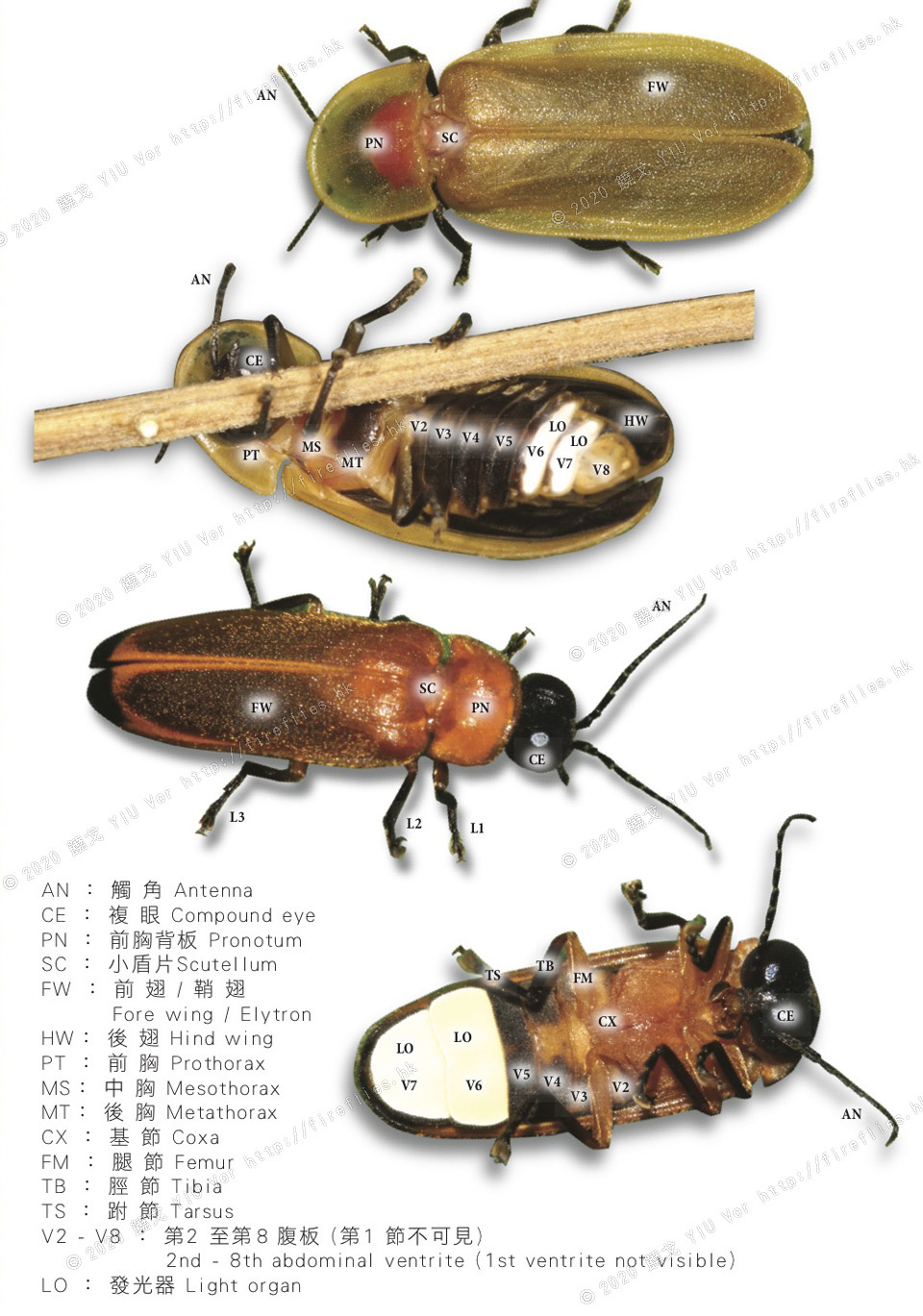
頭 Head
頭可以完全外露、部份外露或穩藏於前胸背板下,此乃其中一項重要分類依據。少數品種如窗螢屬和短腳窗螢屬,前胸背板較前方位置有半透明的窗點,相信是讓下方的複眼可以透視上方景物
Head could be exposed, partially exposed or completely hidden under the pronotum. This is one of the important features for classification. Few species, belonging to the genus Pyrocoelia and Diaphanes, have small transparent area(s) close to the anterior margin of the pronotum. The structure is called vitreous aerolet. It is believed vitreous aerolets are for upward visibility.
半透明的窗點 Vitreous aerolets
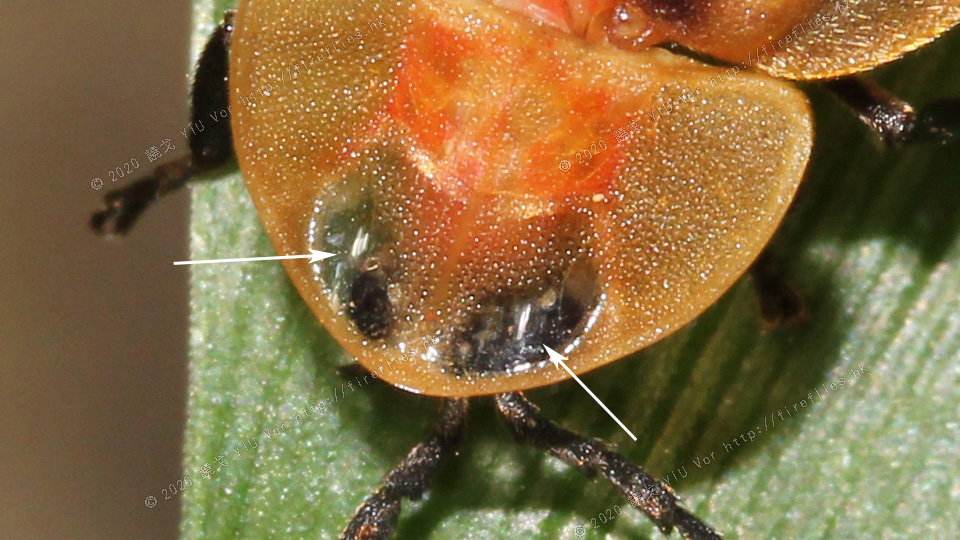
複眼 Compound eyes
複眼大小變化很大,雄螢的複眼常比同種的雌螢的複眼大;具翅能飛的雌性的複眼比不能飛的雌性品種的大;夜行性品種的比日行性品種的大;線狀觸角的雄螢擁有最大的複眼,包括熠螢亞科的全部品種和少數螢亞科的品種;凹眼螢屬和怪眼螢屬的品種雄螢複眼有一深陷缺口。
Compound eyes vary greatly in size. Compound eyes of the male are usually larger than those of the female of the same species. Flightless females have smaller compound eyes than females capable to fly. Nocturnal species generally have larger compound eyes than diurnal species. Species with male equipped with filiform antennae have the most well developed compound eyes, these include all Luciolinae species and a few Lampyrinae species. Compound eyes of genus Rhagophthalmus male and genus Oculogryphus have deep emargination.

觸角 Antennae
觸角用作感應化學訊息,發達的觸角通常伴隨較細小的複眼,反之亦然。螢科的觸角11節,一些品種的雌性觸角節數較少;凹眼螢科的12節。香港螢火蟲有四類觸角:
- 線狀/絲狀
- 鋸齒狀
- 櫛狀
- 雙櫛狀
熠螢亞科的成員雌雄觸角大致相同,其他螢火蟲品種的雄性觸角通常遠比同種雌性的發達。
Antennae are used for detecting chemical signals. Better development antennae usually come with less developed compound eyes and vice-versa. Lampyridae antennae consist of 11 segments. Female of some species have less segments. Rhagophthalmidae has 12 segments. Four types of antennae can be identified from Hong Kong species:
- Filiform.
- Serrate.
- Unipectinate.
- Bipectinate.
Members of Luciolinae have similar antennae for male and female of the same species. For other firefly species, antennae of male are usually much more well developed as compared with female's of the same species.

翅 Wings
和其他甲蟲一樣,螢火蟲的前翅硬化成鞘翅,可保護膜質後翅和腹部,但螢火蟲的鞘翅比較薄和柔軟。雄螢需要最高的活動能力去尋覓雌性,雙翅完整發育;不少雌性的雙翅退化、甚至完全消失,不能飛行,因為這些雌性身軀特別大、又不需要良好的移動能力,多完整可飛行的雙翅並不乎成本效益。
Like other beetles, fireflies' forewings are hardened as elytra, for protecting the hindwings and the abdomen. Male fireflies need highest mobility to search for female, both wings are fully developed and functional. Female of some firefly species only have reduced wings. In some species, wings are completely lacking.

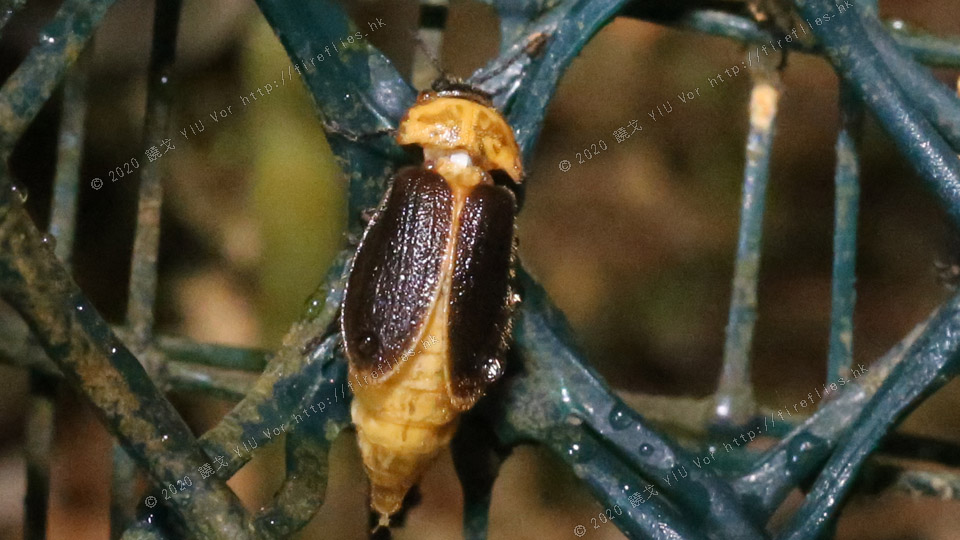

腹 Abdomen
腹部分節,每節有背板和腹板,背板和腹板的數目、形狀、大小和結構對螢火蟲的分類和辦認十分重要。凹眼螢科的雄螢有8節可見腹板,雌螢有9節可見腹板;熠螢亞科的雄螢有6節可見腹板,雌螢有7節可見腹板;螢亞科、弩螢亞科、雙櫛角螢亞科的雄螢有7或8節可見腹板,雌螢若雙翅完整的有6或7節可見腹板,雌螢若雙翅退化或消失的的則有8節可見腹板。
Abdomen segmented, each segment contains tergite and ventrite, number, shape, size and structure of which are important for classification and identification of different firefly species. In Rhagophthalmidae, male has 8 visible abdominal ventrites and female has 9. In Luciolinae, there are 6 visible ventrites in male and 7 visible ventrites in female. In Lampyrinae, Ototretinae and Cyphonocerinae, male has 7 or 8 visible ventrites. Macropterous (wings fully developed) females have 6 or 7 ventrites.
Females with reduced or lost wings have 8 visible abdominal segments.
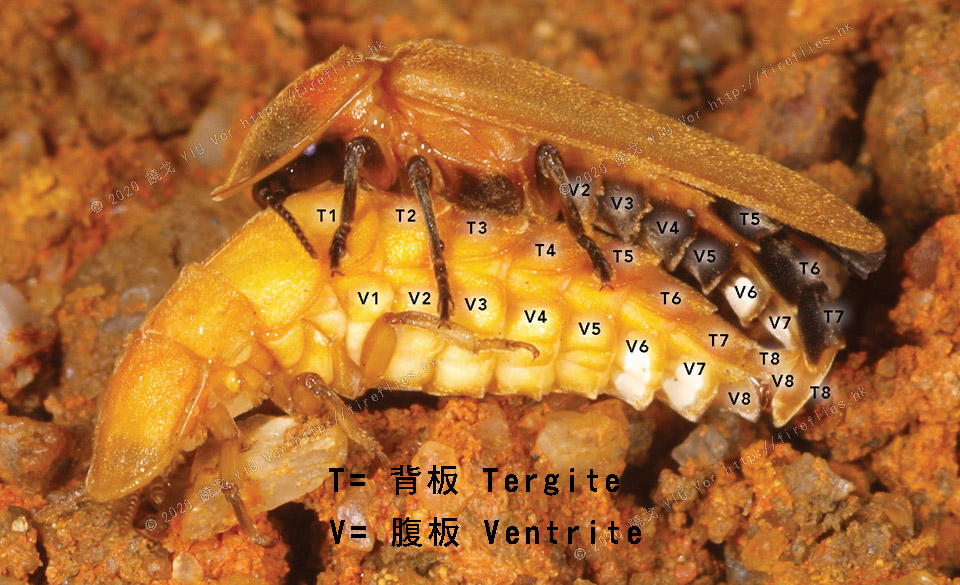
發光器 Light organ
發光器的大小、形狀、位置、和數目,在不同品種之間和同種的雌雄之間可以有很大的差異。發光器可以是一圓點、一片、C形、條狀、橢圓形、長方形或者佔據整片腹板。雌性雙色垂鬚螢近乎全身發光。數目方面,可以是1對、2對、3對、以致33點 (每節3點, 雌性凹眼螢)
The light emitting part is called lantern, luminescent organ, photic organ, photogenic organ or light organ. Size, shape, location and number of light organ could vary greatly between different species or between genders of the same species. The light organ could be a spot, a patch, c-shaped, a strip, oblong, rectangular or occupying the whole ventrite. In female Stenocladius bicoloripes, almost the whole body glows. There could be only one pair, two pairs, three pairs, or even 33 light spots (3 for each segment) as in female Rhagophthalmus

幼蟲形態 Larva Morphology
幼螢通常以黑、褐、黃等與生活環境比較接近的顏色為主,部份品種也會有紅黑配搭的警戒色。
幼蟲多是長形、狹長、前後兩端收窄。身體由頭、三節胸部和九節腹部組成。背面骨化比較明顯、比較硬。體節間膜和腹面的彈性容許身體伸長、縮短卷曲。有些幼蟲可以"蛭式"步行。
頭部可縮入前胸背板下,探測環境和獵食時向前伸出。觸角短、三節;單眼位於兩則。幼蟲不具複眼,而單眼只能感應光暗變化,不能成像。口器非常發達,用於獵食。
陸生幼蟲第1-8腹節的每對側背片有各有1氣孔,在水生幼蟲身上,氣孔被鰓取代。
相比其他品種,窗螢幼蟲具有特別發達的足,這與些屬幼蟲的快速行動和攀爬樹枝能力有關。窗螢幼蟲更會有足抓緊獵物蝸牛的殼。
很多螢火蟲幼蟲具翻縮腺,用以分泌化學物驅散侵襲者。受刺激時,翻縮腺從體節兩側伸出,通常很快縮回體內。
香港已知的全部螢火蟲幼蟲都具備發光器,位於第7腹節或第8腹節,有時兩節皆有發光器。幼蟲的發光,對潛在捕食者乃警戒訊號
腹部未端有一束可翻縮的組織,稱為尾足,尾足用作固定身體、協助步行、捕捉獵物和清潔身體。
Colour of the larvae is usually similar to the living environment, such as black, brown and yellow. A few species have combination of red and dark colour which could be a warning signal to their potential predator. Larvae are generally elongated, slender and more or less tapering in both ends. The body is composed of head, three thoracic and nine abdominal segments. Dorsal side is usually more sclerotized and harder than the ventral side of the body. Intersegmental membranes and flexibility of the ventral part allow certain degree of elongation, shortening and curling of the body. Some larvae can even perform leech-like looping movement
Head is retractable beneath the pronotum and extensible when searching for preys or attacking preys. Antennae short, 3-segmented; ocelli (simple eyes) located on each side. Firefly larvae do not have compound eyes. Ocelli could only sense the brightness level and have no imaging capability. Mouthparts are well developed for predation.
Terrestrial larvae bear a pair of spiracles on the latero-tergites of abdominal segment 1-8. The spiracles are replaced by gills in true aquatic larvae.
Pyrocoelia has much longer and better developed legs compared with other species. This may be associated to their highly mobile behavior and ability of climbing on twigs. Their legs are also frequently used to grasp the snail shell when insect their head into the shell .
Many larvae also bear eversible glands which secret repellent substances. These eversible glands are only occasionally extruded for a short period of time from the lateral sides of each segment when the larva is under stimuli.
Light organs are found in all the recorded larvae from Hong Kong. Light organs exist at abdominal segment 7 , abdominal segment 8 or in some cases at both segment 7 and 8. Light signal emitted by the larvae is an aposematic display to their potential predators
There are a series of eversible filaments at the terminal abdominal segment called pygopods. Pygopods are used as a holdfast for anchorage and assisting locomotion They are also useful for holding the shell of preys, as well as cleaning the body.
窗螢幼蟲蛭式行走 Leech-like Looping Movement of Window a Window Firefly Larva
窗螢幼蟲蛭式行走 Leech-like Looping Movement of Window a Window Firefly Larva from Hong Kong Fireflies on Vimeo.
翻縮腺 Eversible glands
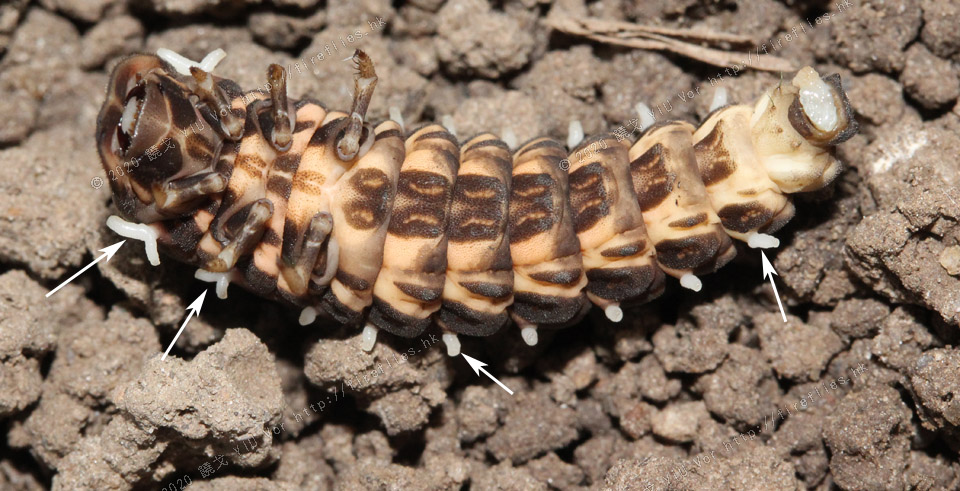
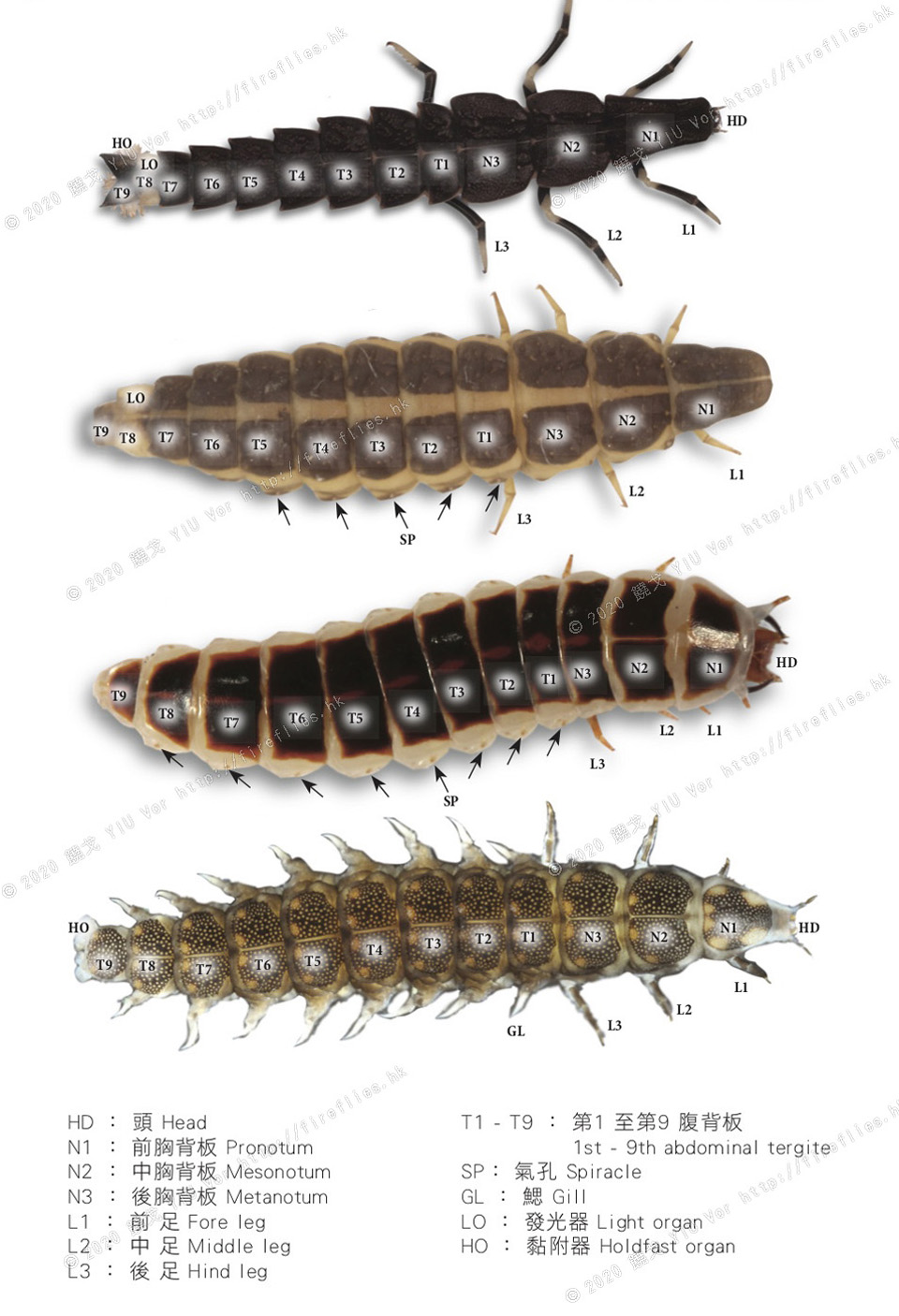
尾足 Pygopods
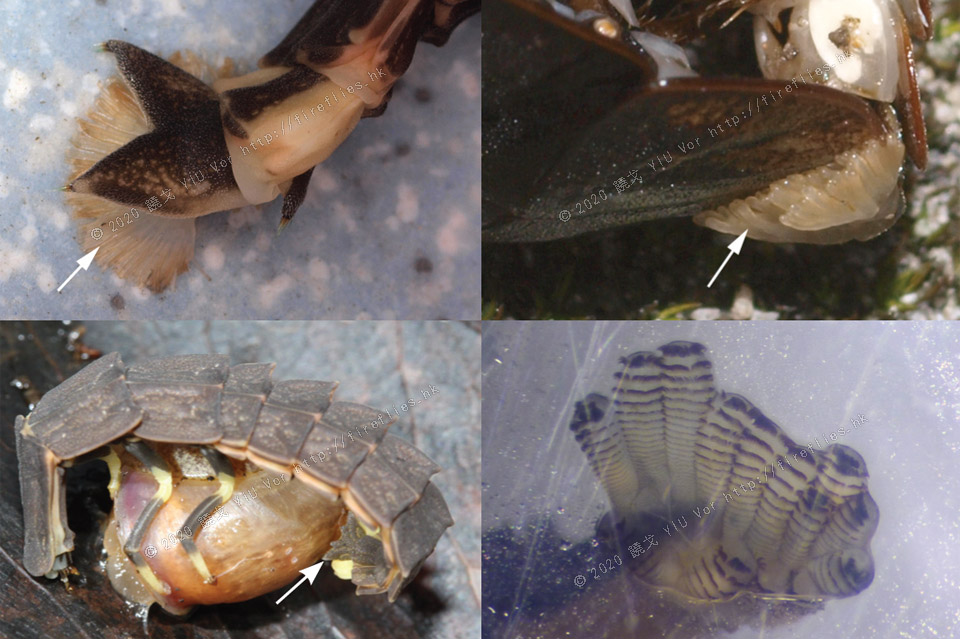
Like other beetles, fireflies' forewings are hardened as elytra, for protecting the hindwings and the abdomen. Male fireflies need highest mobility to search for female, both wings are fully developed and functional. Female of some firefly species only have reduced wings. In some species, wings are completely lacking.
Abdomen segmented, each segment contains tergite and ventrite, number, shape, size and structure of which are important for classification and identification of different firefly species. In Rhagophthalmidae, male has 8 visible abdominal ventrites and female has 9. In Luciolinae, there are 6 visible ventrites in male and 7 visible ventrites in female. In Lampyrinae, Ototretinae and Cyphonocerinae, male has 7 or 8 visible ventrites. Macropterous (wings fully developed) females have 6 or 7 ventrites.
The light emitting part is called lantern, luminescent organ, photic organ, photogenic organ or light organ. Size, shape, location and number of light organ could vary greatly between different species or between genders of the same species. The light organ could be a spot, a patch, c-shaped, a strip, oblong, rectangular or occupying the whole ventrite. In female Stenocladius bicoloripes, almost the whole body glows. There could be only one pair, two pairs, three pairs, or even 33 light spots (3 for each segment) as in female Rhagophthalmus
幼蟲多是長形、狹長、前後兩端收窄。身體由頭、三節胸部和九節腹部組成。背面骨化比較明顯、比較硬。體節間膜和腹面的彈性容許身體伸長、縮短卷曲。有些幼蟲可以"蛭式"步行。